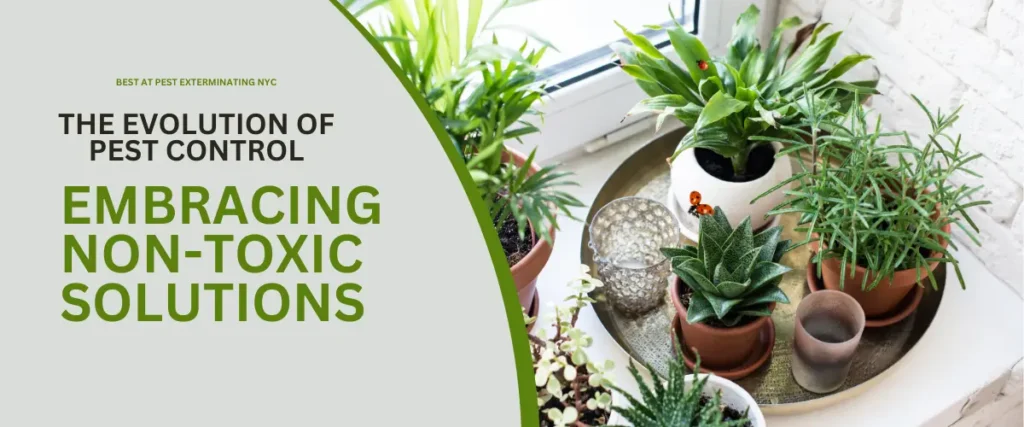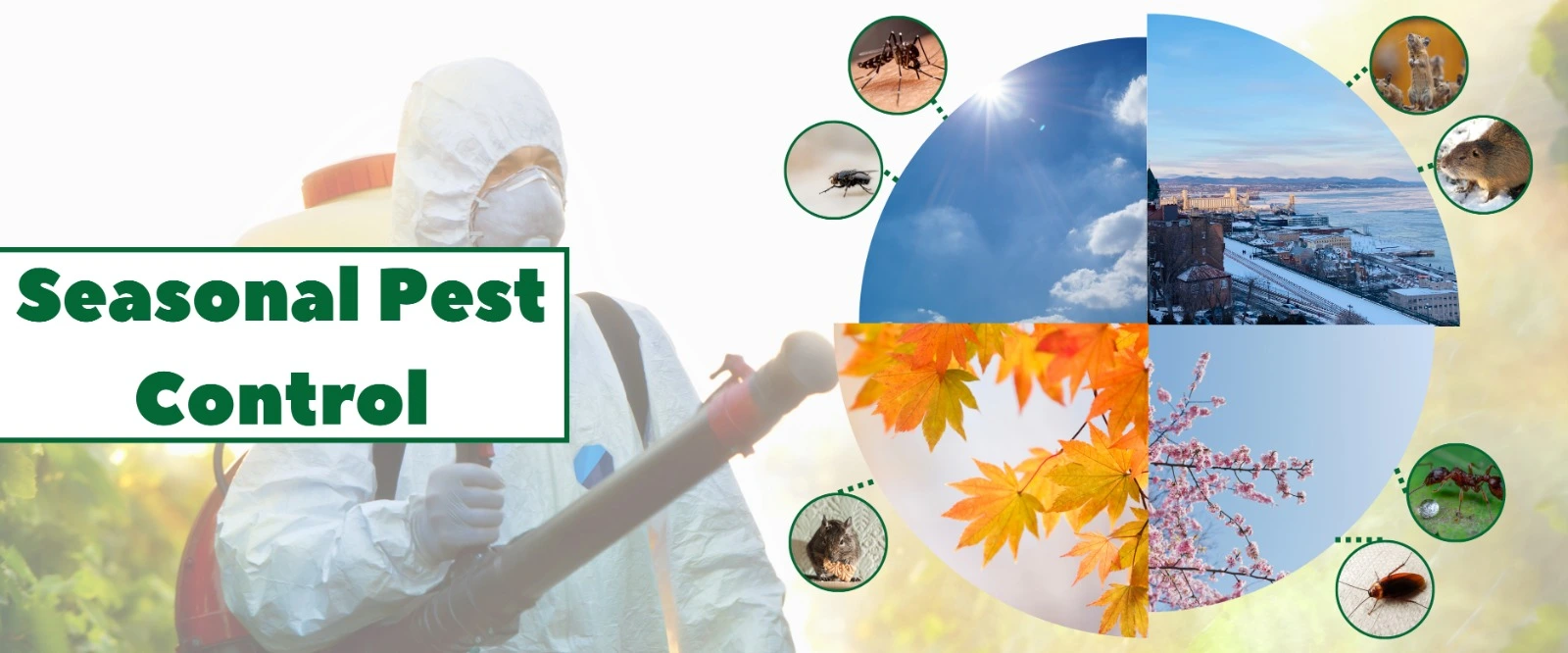
Essential Seasonal Pest Control Tips for NYC Homeowners
Living in a vibrant city like NYC has its perks, but it also comes with unwelcome guests – pests. From ants to cockroaches and even the occasional rodent, these intruders can wreak havoc on your home, spreading disease, damaging property, and disrupting your peace of mind.
Here’s why a proactive approach to pest control is crucial for NYC homeowners:
- Health Risks: Pests can carry and transmit a variety of diseases, some of which can be serious. Rodents, for example, can transmit diseases like hantavirus and leptospirosis, while cockroaches can trigger allergies and asthma.
- Property Damage: Rodents with their sharp teeth can gnaw on wires, furniture, and insulation, leading to costly repairs. Some insects, like termites, can cause structural damage by burrowing through wood.
- Nuisance: Let’s face it, no one enjoys sharing their living space with creepy crawlies. Pests can be unsightly, unsettling, and disrupt your enjoyment of your home.
NYC’s Seasonal Pest Parade: Challenges Throughout the Year
New York City’s distinct seasons bring unique challenges when it comes to pest control. Here’s a breakdown of the year and the specific pest threats to watch out for:
- Spring: As the weather warms, overwintering pests like cockroaches and ants become more active, seeking food and water indoors. This is also the time when mice and rats become more prolific breeders.
- Summer: Hot, humid summers create perfect breeding grounds for mosquitoes, flies, and other moisture-loving insects. Additionally, increased outdoor activity can lead to accidental introductions of ticks and fleas into your home.
- Fall: As the temperatures drop, pests like spiders and rodents seek warm shelter indoors, making this a prime time for increased activity.
- Winter: While some cold-blooded pests become less active, winter can also see an influx of mice and rats seeking warmth as their natural habitats dwindle.
Conquering the Seasons: Essential Pest Control Strategies
With this understanding of NYC’s seasonal pest challenges, we can now delve into the heart of this blog: developing a strategic plan to keep pests at bay throughout the year. We’ll explore specific tactics for each season, from preventative measures to effective elimination techniques, empowering you to create a pest-free haven in your NYC home.
Spring Pest Prevention in NYC: Keep Your Home a Heaven
Spring brings warmer weather, blooming flowers, and unfortunately, a resurgence of unwanted guests – pests! As New Yorkers, we know these critters can be a real nuisance. This guide will equip you with the knowledge and strategies to keep your home pest-free this spring.
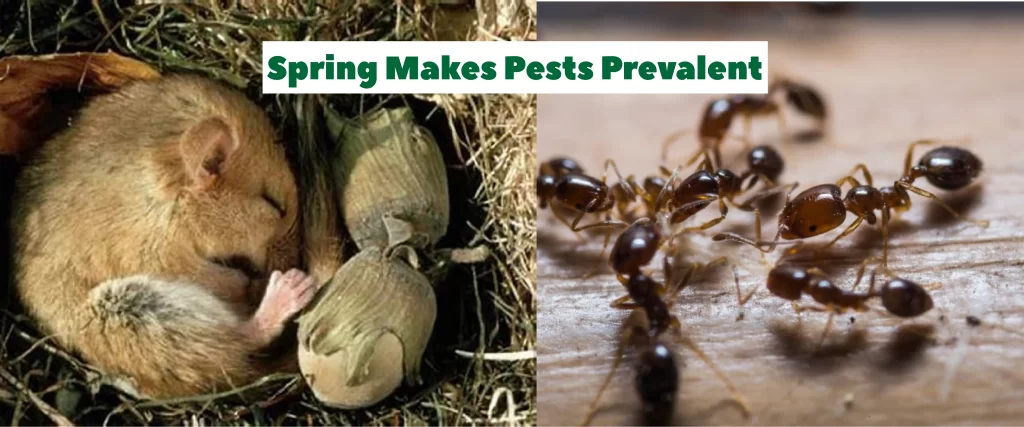
Identifying Common Spring Pests
- Ants: These tiny but persistent insects emerge in droves searching for food sources. Warmer weather and melting snow can expose hidden crumbs and attract them indoors.
- Termites: Spring is prime swarming season for these wood-destroying insects. Moisture from spring rains can activate their nesting sites, and they may seek new territories near your foundation.
- Rodents (Mice & Rats): As the winter chill subsides, these resourceful rodents become more active, searching for food and nesting sites. Your cozy apartment might seem like the perfect haven!
Why Spring Makes Pests Prevalent
- Warmer Temperatures: Increased warmth awakens many pests from dormancy and triggers breeding activity.
- Melting Snow: Spring thaws can reveal hidden food sources for pests and expose potential entry points around your foundation.
- Increased Moisture: Spring rains create damp environments ideal for breeding and attracting moisture-loving pests like roaches and millipedes.
Prevention Tips: Take Control This Spring
- Sealing Entry Points: This is your first line of defense! Inspect windows, doors, foundations, and utility lines for cracks, gaps, or holes. Caulk any openings and replace damaged weather stripping to prevent unwanted visitors.
- Regular Inspection of Home and Garden: Be a pest detective! Regularly check for signs of infestation like droppings, gnaw marks, or unusual trails. In your garden, remove debris piles, trim overgrown branches away from your house, and address any standing water sources like clogged gutters.
- Natural Deterrents and Barriers: Utilize natural repellents strategically. Peppermint oil can deter ants, while bay leaves might discourage roaches. Diatomaceous earth, a natural powder, can act as a physical barrier for crawling insects.
Professional Pest Control Services: When DIY Isn’t Enough
Sometimes, DIY methods aren’t sufficient. Here’s why calling a professional pest control service can be your best bet:
- Expertise: Licensed professionals have the knowledge and experience to identify specific pests and implement targeted treatment plans.
- Safe and Effective Solutions: They use professional-grade products that are safe for your family and pets while effectively eliminating pests.
- Long-Term Prevention: Professional companies can identify and address the root causes of pest problems, preventing future infestations.
Summer Pest Management Strategies: Keep Your Oasis Pest-Free
Summer beckons us outdoors with warm sunshine, barbecues, and evenings spent enjoying the fresh air. Unfortunately, these pleasant moments can be marred by unwelcome guests – summer pests! From buzzing flies to stinging wasps, these critters can turn your outdoor haven into a battleground. But fear not, with the right strategies, you can reclaim your summer paradise.
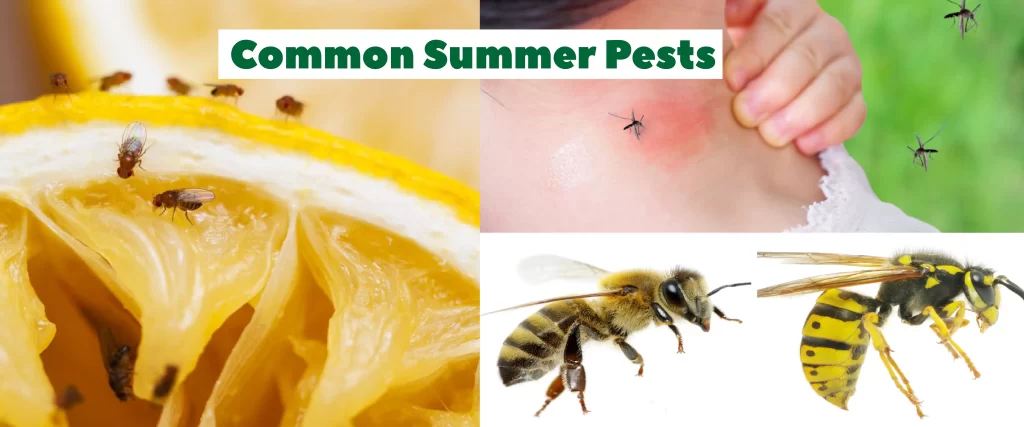
Common Summer Pests: Uninvited Guests at Your Doorstep
- Mosquitoes: These notorious bloodsuckers thrive in warm, humid conditions, making summer their prime time. They not only leave itchy bites but can also transmit diseases.
- Flies: Fruit flies, houseflies, and gnats find summer a breeding bonanza, attracted to food scraps, spills, and garbage. Their presence can be unsanitary and downright annoying.
- Wasps & Bees: While both play a vital role in the ecosystem, their stings can be painful and even life-threatening for those with allergies. Summer is peak season for their activity, especially around sugary drinks and flowering plants.
- Other Insects: From ants on the prowl for crumbs to beetles seeking shelter, summer brings an increase in various insects that can become a nuisance.
Why Summer Brings a Surge in Pest Activity
- Warm Temperatures: Increased heat fuels insect metabolism and reproduction, leading to population booms.
- Humidity: Mosquitoes and other moisture-loving pests thrive in humid environments, making summer ideal for them.
- Food & Water Abundance: Summer barbecues, picnics, and overflowing trash cans create a smorgasbord for pests, attracting them to your property.
- Outdoor Living: As we spend more time outdoors, we become more likely to encounter pests in their natural habitat.
Effective Management Techniques: Fight Back & Enjoy Your Summer
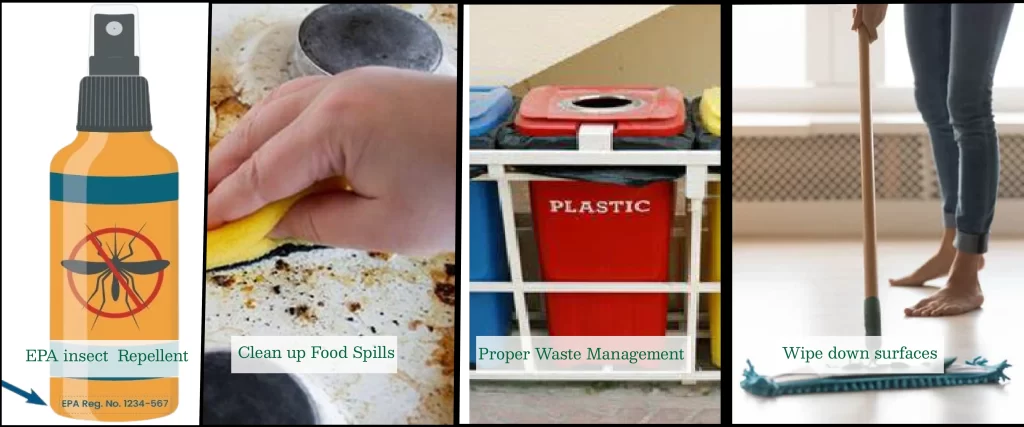
- Safe & Effective Use of Repellents: Apply EPA-registered insect repellents containing DEET, picaridin, or oil of lemon eucalyptus to exposed skin when spending time outdoors.
- Maintain Cleanliness: Don’t give pests a free lunch! Regularly clean up food spills, crumbs, and garbage indoors and outdoors. Wipe down surfaces and keep food covered to deter flies and other scavengers.
- Proper Waste Management: Securely seal trash cans with tight-fitting lids and dispose of garbage regularly. This eliminates a major food source for many pests.
Outdoor & Indoor Strategies: A Two-Pronged Approach
- Outdoor Spaces:
- Gardens: Choose plants that repel insects, like citronella grass or marigolds. Regularly remove weeds and debris that can provide shelter for pests.
- Patios & Decks: Clean up spills and food debris promptly. Consider citronella candles or torches for temporary outdoor pest deterrence.
- Indoor Protection Measures:
- Window Screens: Ensure all windows and doors have properly fitted screens to prevent flying insects from entering.
- Natural Repellents: Strategically place herbs like peppermint or basil near entry points to deter some insects.
- Long-Term Solutions: Consider sealing cracks around windows, doors, and foundations to prevent pests from finding their way inside.
Fall Pest Infestations in New York
As the leaves change color and the temperatures start to drop, many homeowners in New York notice an increase in pest activity. Fall is a critical time for pest control because many pests seek shelter indoors to escape the cold. In this section, we’ll explore fall pest behavior, common pests to watch out for, and effective prevention and control methods to keep your home pest-free.
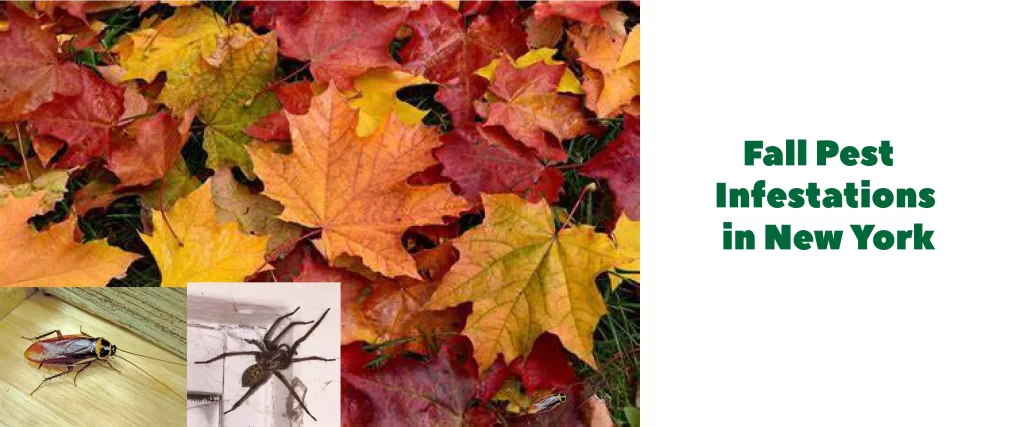
Understanding Fall Pest Behavior
When fall arrives, pests begin to search for warm, sheltered places to spend the winter. Your home becomes an attractive option, offering food, warmth, and protection from the elements. This seasonal migration can lead to an influx of unwanted guests, making it crucial to understand their behavior and take preventive measures.
Common Fall Pests Like Spiders, Cockroaches, and Rodents
- Spiders: Many species of spiders seek indoor environments during fall. While most are harmless, their presence can be unsettling.
- Cockroaches: These resilient pests thrive in warm, humid environments and can carry diseases. They often invade kitchens and bathrooms.
- Rodents: Mice and rats are notorious for seeking shelter indoors during the fall. They can cause significant damage by gnawing on wires, insulation, and food supplies, and they pose health risks through contamination.
Prevention and Control Methods
Inspections for Cracks and Gaps
- Conduct a thorough inspection of your home’s exterior. Look for cracks, gaps, and holes in walls, foundations, windows, and doors.
- Seal any openings with caulk, weather stripping, or steel wool to prevent pests from entering.
- Pay special attention to areas where utility pipes enter the house and around basement windows.
Proper Storage of Food and Waste
- Store food in airtight containers to prevent attracting pests.
- Keep your kitchen clean by promptly wiping up spills and crumbs.
- Dispose of garbage regularly and use sealed trash bins to minimize access for pests.
- Don’t leave pet food out overnight, as it can attract rodents and insects.
Use of Traps and Baits
- Set traps and baits in areas where you’ve noticed pest activity. For rodents, place traps along walls and in hidden areas like behind appliances.
- Use sticky traps for spiders and other crawling insects.
- Be mindful of using baits and traps safely, especially if you have children or pets.
Seasonal Maintenance
Importance of Seasonal Maintenance and Clean-Up
- Yard Maintenance: Keep your yard tidy by raking leaves, trimming bushes, and removing debris that can provide hiding spots for pests.
- Gutter Cleaning: Clean out gutters and downspouts to prevent water accumulation, which can attract pests.
- Storage Areas: Organize and declutter storage areas like basements, attics, and garages. Use plastic bins with tight-fitting lids instead of cardboard boxes, which can harbor pests.
- HVAC Inspection: Have your HVAC system inspected and serviced. Ensure that vents are covered with mesh to prevent pests from entering through the ductwork.
Winter Pest Control in NYC: Keep Your Cozy Home Critter-Free
While winter brings a welcome break from the summer mosquito swarms, it doesn’t mean your NYC apartment is suddenly pest-proof. Cold weather might drive some insects into hiding, but other critters become more active, seeking warmth and shelter inside our cozy homes. This guide will equip you with the knowledge and strategies to keep your winter haven pest-free.
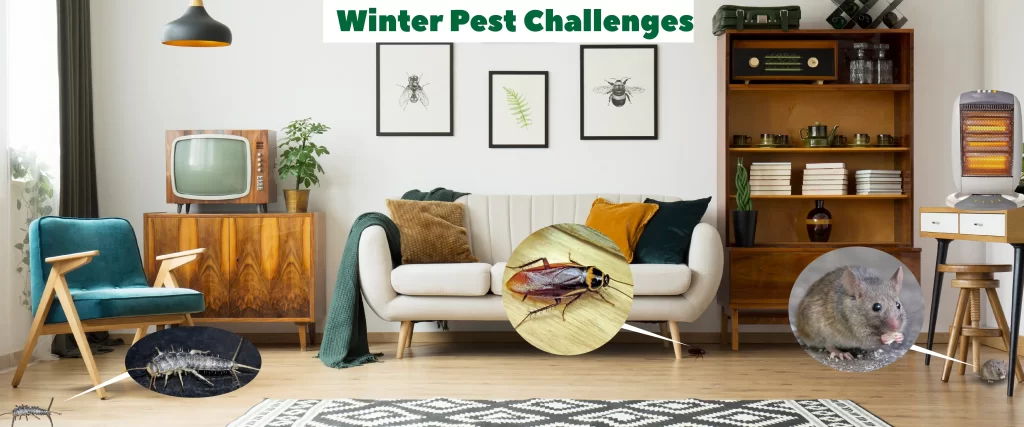
Winter Pest Challenges: Unwanted Guests Craving Your Coziness
- Rodents (Mice & Rats): These resourceful critters become even more active in winter, searching for warmth and food sources. Your well-heated apartment can be an attractive winter destination for them!
- Silverfish: These moisture-loving insects thrive in the warm, humid environments created by winter heating. They’re particularly fond of dark, damp areas like basements and bathrooms.
- Cockroaches: While not as common in cold weather, cockroaches can still be a problem, especially in multi-unit buildings where warmth attracts them.
How Cold Weather Affects Pest Behavior
- Seeking Shelter: As outdoor temperatures drop, many pests like rodents and some insects actively seek warm areas to nest and survive the winter chill.
- Increased Activity: For some pests, winter doesn’t mean hibernation. Rodents and silverfish, for example, become more active indoors as their usual outdoor food sources dwindle.
- Moisture Dependence: Central heating can create dry indoor conditions, forcing moisture-loving pests like cockroaches to seek out damp areas like leaky pipes or bathrooms.
Control and Prevention: Nip Winter Pest Problems in the Bud
- Making Your Home Uninviting: Seal up potential entry points! Inspect windows, doors, foundations, and utility lines for cracks, gaps, or holes. Caulk any openings and replace damaged weather stripping to prevent unwanted visitors.
- Winter-Proofing Your Home: A well-insulated home not only keeps you warm but also makes it less attractive to pests seeking warmth. Invest in proper insulation for your attic, basement, and exterior walls.
- Safe Use of Pesticides Indoors: If you choose to use pesticides indoors, prioritize safety! Always use EPA-registered products and follow label instructions meticulously. Remember, prevention is always the best approach.
Emergency Pest Control: When Winter Brings Unwanted Guests
- Spotting Signs of Infestation: Be vigilant! Keep an eye out for droppings, gnaw marks, unusual trails, or even live sightings of pests.
- Taking Action: If you suspect a pest infestation, don’t wait! Address the issue quickly. Set traps for rodents, eliminate moisture sources to deter silverfish, and consider using baits specifically designed for indoor use (always following safety guidelines).
- When to Call in the Pros: If the DIY approach isn’t working, or the infestation seems severe, don’t hesitate to call a professional pest control service. They have the expertise and resources to identify the specific pest and implement a safe and effective treatment plan.
Why Seasonal Pest Control Makes All the Difference
Conquering pests isn’t a one-size-fits-all battle. Just like our wardrobes change with the seasons, so too should our pest control strategies. As we’ve explored, spring brings awakening pests searching for food, summer sees a surge in activity due to warmth and abundance, and winter finds critters seeking cozy shelter inside.
By understanding these seasonal shifts and implementing targeted tactics, you gain a significant advantage in the fight against unwanted guests.
Here’s the takeaway: Proactive and seasonal pest control is key to a pest-free home. Don’t wait for a full-blown infestation to take action!
Stay Vigilant All Year Round:
- Conduct regular inspections for signs of pests, both indoors and outdoors.
- Address potential entry points by sealing cracks and gaps around windows, doors, and foundations.
- Maintain a clean and sanitary environment to eliminate attractants like food scraps and moisture sources.
Consider Professional Help:
For comprehensive solutions and peace of mind, contacting a professional pest control service is a wise investment. They have the expertise to identify specific pests, recommend targeted treatments, and create a customized plan to keep your home protected year-round.

